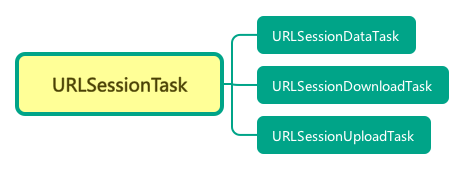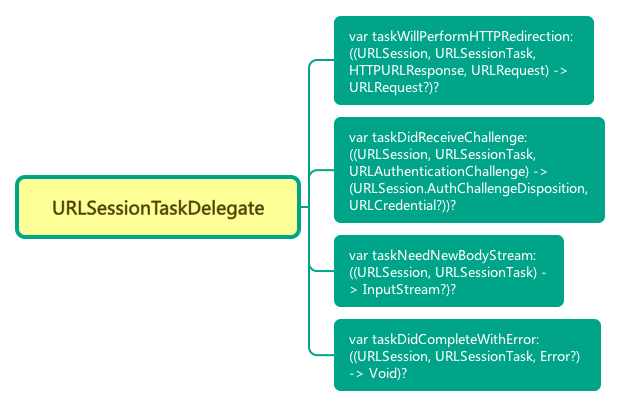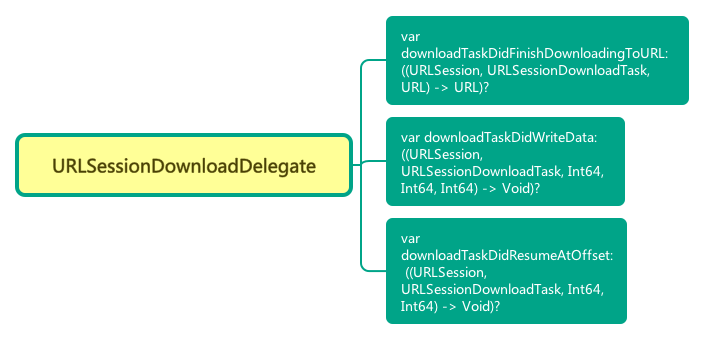本篇介绍Task代理(TaskDelegate.swift)
前言
我相信可能有80%的同学使用AFNetworking或者Alamofire处理网络事件,并且这两个框架都提供了丰富的功能,我也相信很多人都做了二次封装,但事实上,这个二次封装却又异常简单或者是简陋。这篇文章的内容是Task代理,是一篇很独立的文章,大家可以通过这篇文章了解iOS中网络开发是怎么一回事。
那么一条最普通的网络请求,究竟是怎样的一个过程?首先我们根据一个URL和若干个参数生成Request,然后根据Request生成一个会话Session,再根据这个Session生成Task,我们开启Task就完成了这个请求。当然这一过程之中还会包含重定向,数据上传,挑战,证书等等一系列的配置信息。
我们再聊聊代理的问题,不管是在网络请求中,还是再其他的地方,代理都类似于一个管理员的身份。这在业务架构中是一个很好的主意。假如我把代理想象成一个人,那么这个人的工作是什么呢?
-
提供我所需要的数据,这一点很重要。获取的数据也分两种:加工过的和未加工过的。举个例子,有一个控制器,里边需要处理好几个不同类型的cell,每个cell都有属于自己的适配器来控制样式和数据处理,面对这种情况,可以设计一个代理,每当刷新界面的时候,直接从代理中请求处理过的适配器数据,那么这种情况下的数据就是被加工过的,如果数据加工是一个复杂的工作,可以设计一个数据加工的代理。这就涉及了下边的代理的另外一项工作。
-
提供处理业务的方法,这往往被用于事件的传递。这是一种狭义上的代理,是一个协议。在开发中,不管是view还是Controller,都可以利用代理传递事件。但我们这里说的不是协议,协议必须要求我们实现它的属性和方法,这对上边提到的‘人’是不友好的。在真实的理想的场景中,我和代理的交互只有两种情况:
- 给我想要的数据
- 我知道这个业务你比较精通,当有和你相关的事情的时候,我会通知你
如果对上边的内容不太明白,只需要明白,有的代理是一个协议,有的代理是一个'人',在某些让你头疼的复杂的业务中,用代理'人'去处理。我在想是不是不叫代理,叫Manager更合适。
URLSessionTask
URLSessionTask是对task最基本的封装。按照请求的目的和响应的结果可以分为:
- 获取Data
- 下载
- 上传
- Stream, 这个在这篇中不做讲解

上边图中表示了一种继承关系,与之相对应的代理如下图:




我会在下边详细讲解这些代理方法。
TaskDelegate
TaskDelegate位于继承链的最底层,因此它提供了一些最基础的东西,这些东西也是其他Delegate共享的,我们先看看属性:
// MARK: Properties
/// The serial operation queue used to execute all operations after the task completes.
open let queue: OperationQueue
/// The data returned by the server.
public var data: Data? { return nil }
/// The error generated throughout the lifecyle of the task.
public var error: Error?
var task: URLSessionTask? {
didSet { reset() }
}
var initialResponseTime: CFAbsoluteTime?
var credential: URLCredential?
var metrics: AnyObject? // URLSessionTaskMetrics
我们来分析下这些属性:
-
queue: OperationQueue很明显这是一个队列,队列中可以添加很多operation。队列是可以被暂停的,通过把isSuspended设置为true就可以让队列中的所有operation暂停,直到isSuspended设置为false后,operation才会开始执行。在Alamofire中,放入该队列的operation有一下几种情况:- 注意:该队列会在任务完成之后把
isSuspended设置为false - 一个Request的endTime,在任务完成后调用,就可以为Request设置请求结束时间
- response处理,Alamofire中的响应回调是链式的,原理就是把这些回调函数通过operation添加到队列中,因此也保证了回调函数的访问顺序是正确的
- 上传数据成功后,删除临时文件,这个后续的文章会解释的
- 注意:该队列会在任务完成之后把
-
data: Data?表示服务器返回的Data,这个可能为空 -
error: Error?表示该代理生命周期内有可能出现的错误,这一点很重要,我们在写一个代理或者manager的时候,可以添加这么一个错误属性,专门抓取生命周期内的错误。 -
task: URLSessionTask?表示一个task,对于本代理而言,task是很重要的一个属性。 -
initialResponseTime: CFAbsoluteTime?当task是URLSessionDataTask时,表示接收到数据的时间;当task是URLSessionDownloadTask时,表示开始写数据的时间;当task是URLSessionUploadTask时,表示上传数据的时间; -
credential: URLCredential?表示证书,如果给该代理设置了这个属性,在它里边的证书验证方法中会备用到 -
metrics: AnyObject?apple提供了一个统计task信息的类URLSessionTaskMetrics,可以统计跟task相关的一些信息,包括和task相关的所有事务,task的开始和结束时间,task的重定向的次数。
上边的这些属性中,可以留意一下queue的使用方法,尽量为设计的代理添加错误处理机制。
Alamofire使用类似Properties,Lifecycle等等关键字来分割文件的,看完了上边的属性,我们在看看Lifecycle。
// MARK: Lifecycle
init(task: URLSessionTask?) {
self.task = task
self.queue = {
let operationQueue = OperationQueue()
operationQueue.maxConcurrentOperationCount = 1
operationQueue.isSuspended = true
operationQueue.qualityOfService = .utility
return operationQueue
}()
}
func reset() {
error = nil
initialResponseTime = nil
}
reset函数把error和initialResponseTime都置为nil,这个没什么好说的,在init函数中队列的创建很有意思。在swift中,如果我们要创建一个对象,不管是view还是别的,都可以采用这样的方式:创建一个函数,然后立刻调用,这很像JavaScript的用法。
lazy var label: UILabel = {
let view = UILabel()
view.backgroundColor = .clear
view.textAlignment = .center
view.textColor = .white
view.font = .boldSystemFont(ofSize: 18)
self.contentView.addSubview(view)
return view
}()
operationQueue.isSuspended = true可以保证队列中的operation都是暂停状态,正常情况下,operation在被加入到队列中后,会尽快执行。
在swift中函数是一等公民,可以当参数和返回值来使用。同oc的block一样,我们可以把他们当成一个属性,目的是提前告诉代理当遇到指定的事件时应该怎么做?在YYModel中有一小段代码就是关于Block当返回值的妙用。我们看看TaskDelegate下的四个相关函数:
// MARK: URLSessionTaskDelegate
var taskWillPerformHTTPRedirection: ((URLSession, URLSessionTask, HTTPURLResponse, URLRequest) -> URLRequest?)?
var taskDidReceiveChallenge: ((URLSession, URLSessionTask, URLAuthenticationChallenge) -> (URLSession.AuthChallengeDisposition, URLCredential?))?
var taskNeedNewBodyStream: ((URLSession, URLSessionTask) -> InputStream?)?
var taskDidCompleteWithError: ((URLSession, URLSessionTask, Error?) -> Void)?
我们先看第一个函数,这个函数对应的代理方法如下:
@objc(URLSession:task:willPerformHTTPRedirection:newRequest:completionHandler:)
func urlSession(
_ session: URLSession,
task: URLSessionTask,
willPerformHTTPRedirection response: HTTPURLResponse,
newRequest request: URLRequest,
completionHandler: @escaping (URLRequest?) -> Void)
{
var redirectRequest: URLRequest? = request
if let taskWillPerformHTTPRedirection = taskWillPerformHTTPRedirection {
redirectRequest = taskWillPerformHTTPRedirection(session, task, response, request)
}
completionHandler(redirectRequest)
}
上边的函数处理的问题是请求重定向问题,我们大概讲一下重定向是怎么一回事:Web服务器有时会返回重定向响应而不是成功的报文。Web服务器可以将浏览器重定向到其他地方来执行请求。重定向响应由返回码3XX说明。Location响应首部包含了内容的新地址或优选地址的URI重定向可用于下列情况:
- 永久撤离的资源:资源可能被移动到新的位置,或者被重新命名,有了一个新的URI。Web服务器返回301 Moved Permanently
- 临时撤离的资源:如果资源被临时撤离或重命名,Web服务器返回303 See Other 或307 Temproary Redirect
- URL增强:服务器通常用重定向来重写URL,往往用于嵌入上下文。Web服务器返回303 See Other 或307 Temproary Redirect
- 负载均衡:如果一个超载的服务器收到一条请求,服务器可以将客户端重新定向到一个负载不大的服务器。Web服务器返回303 See Other 或307 Temproary Redirect
- 服务器关联:Web服务器可能会有某些用户的本地信息,服务器可以将客户端重新定向到包含那个客户端信息的服务器上去。Web服务器返回303 See Other 或307 Temproary Redirect
- 规范目录名称:客户端请求的URI是一个不带尾部斜线的目录名时,大多数服务器都会将客户端重定向到Hige加了尾部斜线的URI上。
上边的重定向函数要求返回一个redirectRequest,就是重定向的Request,Alamofire的处理方法就是,如果给代理的重定向处理函数赋值了,就返回代理函数的返回值,否则返回服务器返回的Request。
第二个函数用于处理验证相关的事务。我们先讲讲disposition,他的类型是URLSession.AuthChallengeDisposition,其实就是一个枚举:
@available(iOS 7.0, *)
public enum AuthChallengeDisposition : Int {
case useCredential
case performDefaultHandling
case cancelAuthenticationChallenge
case rejectProtectionSpace
}
这个授权配置一共有四个选项:
-
useCredential表示使用证书 -
performDefaultHandling表示采用默认的方式,这个方式跟服务器返回authenticationMethod有很大关系,我简单列一些常用的methodNSURLAuthenticationMethodHTTPBasic基本认证NSURLAuthenticationMethodHTTPDigest摘要认证NSURLAuthenticationMethodClientCertificate客户端证书认证NSURLAuthenticationMethodServerTrust表示返回的证书要使用serverTrust创建
-
cancelAuthenticationChallenge表示取消认证 -
rejectProtectionSpace表示拒绝认证
对于验证而言,有三种方式:
- 客户端验证
- 服务器验证
- 双向验证
我们先给出Alamofire中的函数,然后在分析:
@objc(URLSession:task:didReceiveChallenge:completionHandler:)
func urlSession(
_ session: URLSession,
task: URLSessionTask,
didReceive challenge: URLAuthenticationChallenge,
completionHandler: @escaping (URLSession.AuthChallengeDisposition, URLCredential?) -> Void)
{
var disposition: URLSession.AuthChallengeDisposition = .performDefaultHandling
var credential: URLCredential?
if let taskDidReceiveChallenge = taskDidReceiveChallenge {
(disposition, credential) = taskDidReceiveChallenge(session, task, challenge)
} else if challenge.protectionSpace.authenticationMethod == NSURLAuthenticationMethodServerTrust {
let host = challenge.protectionSpace.host
if
let serverTrustPolicy = session.serverTrustPolicyManager?.serverTrustPolicy(forHost: host),
let serverTrust = challenge.protectionSpace.serverTrust
{
if serverTrustPolicy.evaluate(serverTrust, forHost: host) {
disposition = .useCredential
credential = URLCredential(trust: serverTrust)
} else {
disposition = .cancelAuthenticationChallenge
}
}
} else {
if challenge.previousFailureCount > 0 {
disposition = .rejectProtectionSpace
} else {
credential = self.credential ?? session.configuration.urlCredentialStorage?.defaultCredential(for: challenge.protectionSpace)
if credential != nil {
disposition = .useCredential
}
}
}
completionHandler(disposition, credential)
}
如果服务器需要验证客户端的,我们只需要给TaskDelegate的 var taskDidReceiveChallenge: ((URLSession, URLSessionTask, URLAuthenticationChallenge) -> (URLSession.AuthChallengeDisposition, URLCredential?))?赋值就行了。
这里有一个很重要的问题,HTTPS并不会触发上边的回调函数,原因就是NSURLSession内部有一个根证书,内部会跟服务器的证书进行验证,如果服务器的证书是证书机构颁发的话,就可以顺利通过验证,否则会报错。
另一个很重要的问题是,上边的方法在何种情况下触发,按照apple的说法URL Session Programming Guide,当服务器响应头中包含WWW-Authenticate或者使用 proxy authentication TLS trust validation时,上边的方法就会被触发,其他情况下都不会触发。
Alamofire是双向验证的
双向验证的过程:
- 当服务器返回的
challenge.protectionSpace.authenticationMethod == NSURLAuthenticationMethodServerTrust时,服务器提供了一个服务器信任的证书,但这个证书也仅仅是服务器自己信任的,攻击者完全可以提供一个证书骗过客户端,基于这个问题,客户端需要验证服务端的证书 - Alamofire中通过
ServerTrustPolicy.swift这个类来验证证书,大概过程就是拿本地的证书跟服务端返回的证书进行对比,如果客户端存在相同的证书就表示通过,这个过程我会在ServerTrustPolicy.swift那篇文章中给出详细的解答
因此,客户端和服务端要建立SSL只需要两步就行了:
- 服务端返回
WWW-Authenticate响应头,并返回自己信任证书 - 客户端验证证书,然后用证书中的公钥把数据加密后发送给服务端
第三个函数:
///This delegate method is called under two circumstances:
///To provide the initial request body stream if the task was created with uploadTask(withStreamedRequest:)
///To provide a replacement request body stream if the task needs to resend a request that has a body stream because of an authentication challenge or other recoverable server error.
///Note
///You do not need to implement this if your code provides the request body using a file URL or an NSData object.
@objc(URLSession:task:needNewBodyStream:)
func urlSession(
_ session: URLSession,
task: URLSessionTask,
needNewBodyStream completionHandler: @escaping (InputStream?) -> Void)
{
var bodyStream: InputStream?
if let taskNeedNewBodyStream = taskNeedNewBodyStream {
bodyStream = taskNeedNewBodyStream(session, task)
}
completionHandler(bodyStream)
}
当给task的Request提供一个body stream时才会调用,我们不需要关心这个方法,即使我们通过fileURL或者NSData上传数据时,该函数也不会被调用,使用场景很少。
第四个函数:
@objc(URLSession:task:didCompleteWithError:)
func urlSession(_ session: URLSession, task: URLSessionTask, didCompleteWithError error: Error?) {
if let taskDidCompleteWithError = taskDidCompleteWithError {
taskDidCompleteWithError(session, task, error)
} else {
if let error = error {
if self.error == nil { self.error = error }
if
let downloadDelegate = self as? DownloadTaskDelegate,
let resumeData = (error as NSError).userInfo[NSURLSessionDownloadTaskResumeData] as? Data
{
downloadDelegate.resumeData = resumeData
}
}
queue.isSuspended = false
}
}
该函数在请求完成后被调用,值得注意的是error不为nil的情况,除了给自身的error属性赋值外,针对下载任务做了特殊处理,就是把当前已经下载的数据保存在downloadDelegate.resumeData中,有点像断点下载。
DataTaskDelegate
DataTaskDelegate继承自TaskDelegate,实现了URLSessionDataDelegate协议。因此下边我们也会讲解URLSessionDataDelegate协议的方法。我们还是先看这里边的属性:
// MARK: Properties
var dataTask: URLSessionDataTask { return task as! URLSessionDataTask }
override var data: Data? {
if dataStream != nil {
return nil
} else {
return mutableData
}
}
var progress: Progress
var progressHandler: (closure: Request.ProgressHandler, queue: DispatchQueue)?
var dataStream: ((_ data: Data) -> Void)?
private var totalBytesReceived: Int64 = 0
private var mutableData: Data
private var expectedContentLength: Int64?
我们对这些属性给出一定的解释:
dataTask: URLSessionDataTaskDataTaskDelegate管理URLSessionDataTaskdata: Data?同样是返回Data,但这里有一点不同,如果定义了dataStream方法的话,这个data返回为nilprogress: Progress进度progressHandler这不是函数,是一个元组,什么时候调用,在下边的方法中给出说明dataStream自定义的数据处理函数totalBytesReceived已经接受的数据mutableData保存数据的容器expectedContentLength需要接受的数据的总大小
DataTaskDelegate的生命周期:
// MARK: Lifecycle
override init(task: URLSessionTask?) {
mutableData = Data()
progress = Progress(totalUnitCount: 0)
super.init(task: task)
}
override func reset() {
super.reset()
progress = Progress(totalUnitCount: 0)
totalBytesReceived = 0
mutableData = Data()
expectedContentLength = nil
}
这些没什么好说的,我们在看看有哪些函数:
// MARK: URLSessionDataDelegate
var dataTaskDidReceiveResponse: ((URLSession, URLSessionDataTask, URLResponse) -> URLSession.ResponseDisposition)?
var dataTaskDidBecomeDownloadTask: ((URLSession, URLSessionDataTask, URLSessionDownloadTask) -> Void)?
var dataTaskDidReceiveData: ((URLSession, URLSessionDataTask, Data) -> Void)?
var dataTaskWillCacheResponse: ((URLSession, URLSessionDataTask, CachedURLResponse) -> CachedURLResponse?)?
URLSessionDataDelegate有四个函数,我们先看第一个函数:
func urlSession(
_ session: URLSession,
dataTask: URLSessionDataTask,
didReceive response: URLResponse,
completionHandler: @escaping (URLSession.ResponseDisposition) -> Void)
{
var disposition: URLSession.ResponseDisposition = .allow
expectedContentLength = response.expectedContentLength
if let dataTaskDidReceiveResponse = dataTaskDidReceiveResponse {
disposition = dataTaskDidReceiveResponse(session, dataTask, response)
}
completionHandler(disposition)
}
当收到服务端的响应后,该方法被触发。在这个函数中,我们能够获取到和数据相关的一些参数,大家可以想象成响应头。Alamofire中给出了一个函数dataTaskDidReceiveResponse,我们可以利用这个函数控制是不是要继续获取数据,默认是.allow。
我们看第二个函数:
func urlSession(
_ session: URLSession,
dataTask: URLSessionDataTask,
didBecome downloadTask: URLSessionDownloadTask)
{
dataTaskDidBecomeDownloadTask?(session, dataTask, downloadTask)
}
在上边的disposition配置中,disposition的类型是URLSession.ResponseDisposition,我们看看这个枚举:
public enum ResponseDisposition : Int {
case cancel /* Cancel the load, this is the same as -[task cancel] */
case allow /* Allow the load to continue */
case becomeDownload /* Turn this request into a download */
@available(iOS 9.0, *)
case becomeStream /* Turn this task into a stream task */
}
当选择了becomeDownload后,就会触发上边的第二个函数,在函数中会提供一个新的downloadTask。这就给我们一个把dataTask转换成downloadTask的机会
那么我们把dataTask转换成downloadTask究竟有什么用呢?我想到了一个使用场景,假如给定一个URL,返回的数据是Data,其实我想把这些数据下载下来,那么就可以使用上边的这种技术了。举个例子,https://baidu.com打开这个url会直接显示网页,使用上边的技术,打开这个url会直接下载网页。我并没有验证上边的想法。
我们继续看第三个函数:
func urlSession(_ session: URLSession, dataTask: URLSessionDataTask, didReceive data: Data) {
if initialResponseTime == nil { initialResponseTime = CFAbsoluteTimeGetCurrent() }
if let dataTaskDidReceiveData = dataTaskDidReceiveData {
dataTaskDidReceiveData(session, dataTask, data)
} else {
if let dataStream = dataStream {
dataStream(data)
} else {
mutableData.append(data)
}
let bytesReceived = Int64(data.count)
totalBytesReceived += bytesReceived
let totalBytesExpected = dataTask.response?.expectedContentLength ?? NSURLSessionTransferSizeUnknown
progress.totalUnitCount = totalBytesExpected
progress.completedUnitCount = totalBytesReceived
if let progressHandler = progressHandler {
progressHandler.queue.async { progressHandler.closure(self.progress) }
}
}
}
这个方法算是核心方法,我在MCDownloadManager中实现下载的核心方法就是这个方法,不同之处是,Alamofire把数据放入对象中,而我把数据写入本地文件中。对这个函数内部就不做解释了,主要就是对自定义函数和进度的一些处理。
我们看第四个函数:
func urlSession(
_ session: URLSession,
dataTask: URLSessionDataTask,
willCacheResponse proposedResponse: CachedURLResponse,
completionHandler: @escaping (CachedURLResponse?) -> Void)
{
var cachedResponse: CachedURLResponse? = proposedResponse
if let dataTaskWillCacheResponse = dataTaskWillCacheResponse {
cachedResponse = dataTaskWillCacheResponse(session, dataTask, proposedResponse)
}
completionHandler(cachedResponse)
}
其实,往往这样的函数才是我们应该注意的,最常见的接受响应,处理数据,请求完成都是我们很熟悉的方法,因此更应该多多注意这些不太熟悉的方法。
该函数用于处理是否需要缓存响应,Alamofire默认是缓存这些response的,但是每次发请求,它不会再缓存中读取。
DownloadTaskDelegate
DownloadTaskDelegate继承自TaskDelegate,实现了URLSessionDownloadDelegate协议。因此下边我们也会讲解URLSessionDownloadDelegate协议的方法。我们还是先看这里边的属性:
// MARK: Properties
var downloadTask: URLSessionDownloadTask { return task as! URLSessionDownloadTask }
var progress: Progress
var progressHandler: (closure: Request.ProgressHandler, queue: DispatchQueue)?
var resumeData: Data?
override var data: Data? { return resumeData }
var destination: DownloadRequest.DownloadFileDestination?
var temporaryURL: URL?
var destinationURL: URL?
var fileURL: URL? { return destination != nil ? destinationURL : temporaryURL }
这些属性中有和上边介绍的属性重复的部分,我们只对不重复的部分给出说明:
downloadTask和URLSessionDownloadDelegate相对应的URLSessionDownloadTaskresumeData在上边我们提到过,当请求完成后,如果error不为nil,如果是DownloadTaskDelegate,就会给这个属性赋值data返回resumeDatadestination通过这个函数可以自定义文件保存目录和保存方式,这个保存方式分两种,为URl创建文件夹,删除已经下载且存在的文件,这个会在后续的文章中提到temporaryURL临时的URLdestinationURL数据存储URLfileURL返回文件的路径,如果destination不为nil,就返回destinationURL,否则返回temporaryURL
生命周期:
// MARK: Lifecycle
override init(task: URLSessionTask?) {
progress = Progress(totalUnitCount: 0)
super.init(task: task)
}
override func reset() {
super.reset()
progress = Progress(totalUnitCount: 0)
resumeData = nil
}
和下载相关的代理函数有三个:
// MARK: URLSessionDownloadDelegate
var downloadTaskDidFinishDownloadingToURL: ((URLSession, URLSessionDownloadTask, URL) -> URL)?
var downloadTaskDidWriteData: ((URLSession, URLSessionDownloadTask, Int64, Int64, Int64) -> Void)?
var downloadTaskDidResumeAtOffset: ((URLSession, URLSessionDownloadTask, Int64, Int64) -> Void)?
我们先看看第一个函数:
func urlSession(
_ session: URLSession,
downloadTask: URLSessionDownloadTask,
didFinishDownloadingTo location: URL)
{
temporaryURL = location
guard
let destination = destination,
let response = downloadTask.response as? HTTPURLResponse
else { return }
let result = destination(location, response)
let destinationURL = result.destinationURL
let options = result.options
self.destinationURL = destinationURL
/// 说明在编码过程中,对于存在可能出现错误的地方,一定要做error处理
do {
if options.contains(.removePreviousFile), FileManager.default.fileExists(atPath: destinationURL.path) {
try FileManager.default.removeItem(at: destinationURL)
}
if options.contains(.createIntermediateDirectories) {
let directory = destinationURL.deletingLastPathComponent()
try FileManager.default.createDirectory(at: directory, withIntermediateDirectories: true)
}
try FileManager.default.moveItem(at: location, to: destinationURL)
} catch {
self.error = error
}
}
对于这样的代理方法,我们首先要做的就是弄明白在什么情况下它会被触发。当数据下载完成后,该函数被触发。系统会把数据下载到一个临时的locationURL的地方,我们就是通过这个URL拿到数据的。上边函数内的代码主要是把数据复制到目标路径中。
但是我有一个疑问?按照apple文档的内容:If you choose to open the file for reading, you should do the actual reading in another thread to avoid blocking the delegate queue.应该在另一个线程来读取数据,这样才不会阻塞当前的代理线程,不知道有什么影响?
我们来看第二个函数:
func urlSession(
_ session: URLSession,
downloadTask: URLSessionDownloadTask,
didWriteData bytesWritten: Int64,
totalBytesWritten: Int64,
totalBytesExpectedToWrite: Int64)
{
if initialResponseTime == nil { initialResponseTime = CFAbsoluteTimeGetCurrent() }
if let downloadTaskDidWriteData = downloadTaskDidWriteData {
downloadTaskDidWriteData(
session,
downloadTask,
bytesWritten,
totalBytesWritten,
totalBytesExpectedToWrite
)
} else {
progress.totalUnitCount = totalBytesExpectedToWrite
progress.completedUnitCount = totalBytesWritten
if let progressHandler = progressHandler {
progressHandler.queue.async { progressHandler.closure(self.progress) }
}
}
}
该代理方法在数据下载过程中被触发,主要的作用就是提供下载进度。这个比较简单,我们看看第三个函数:
func urlSession(
_ session: URLSession,
downloadTask: URLSessionDownloadTask,
didResumeAtOffset fileOffset: Int64,
expectedTotalBytes: Int64)
{
if let downloadTaskDidResumeAtOffset = downloadTaskDidResumeAtOffset {
downloadTaskDidResumeAtOffset(session, downloadTask, fileOffset, expectedTotalBytes)
} else {
progress.totalUnitCount = expectedTotalBytes
progress.completedUnitCount = fileOffset
}
}
是这样的,如果一个下载的task是可以恢复的,那么当下载被取消或者失败后,系统会返回一个resumeData对象,这个对象包含了一些跟这个下载task相关的一些信息,有了它就能重新创建下载task,创建方法有两个:downloadTask(withResumeData:) 和downloadTask(withResumeData:completionHandler:),当task开始后,上边的代理方法就会被触发。
UploadTaskDelegate
UploadTaskDelegate继承自DataTaskDelegate。对于上传数据来说最麻烦的就是多表单数据的上传,这个我们会在后续的MultipartFormData.swift给出详细的解释。
我们先看看它的属性有哪些?
// MARK: Properties
var uploadTask: URLSessionUploadTask { return task as! URLSessionUploadTask }
var uploadProgress: Progress
var uploadProgressHandler: (closure: Request.ProgressHandler, queue: DispatchQueue)?
这些和上边出现的内容有重叠,在这里就不多做解释了,我们再看看生命周期:
// MARK: Lifecycle
override init(task: URLSessionTask?) {
uploadProgress = Progress(totalUnitCount: 0)
super.init(task: task)
}
override func reset() {
super.reset()
uploadProgress = Progress(totalUnitCount: 0)
}
也没什么好说的,再看看函数:
// MARK: URLSessionTaskDelegate
var taskDidSendBodyData: ((URLSession, URLSessionTask, Int64, Int64, Int64) -> Void)?
func URLSession(
_ session: URLSession,
task: URLSessionTask,
didSendBodyData bytesSent: Int64,
totalBytesSent: Int64,
totalBytesExpectedToSend: Int64)
{
if initialResponseTime == nil { initialResponseTime = CFAbsoluteTimeGetCurrent() }
if let taskDidSendBodyData = taskDidSendBodyData {
taskDidSendBodyData(session, task, bytesSent, totalBytesSent, totalBytesExpectedToSend)
} else {
uploadProgress.totalUnitCount = totalBytesExpectedToSend
uploadProgress.completedUnitCount = totalBytesSent
if let uploadProgressHandler = uploadProgressHandler {
uploadProgressHandler.queue.async { uploadProgressHandler.closure(self.uploadProgress) }
}
}
}
该函数主要目的是提供上传的进度,在Alamofire中,上传数据用的是stream,这个会在后续文章中给出详细的解释。
总结
我个人解读源码的方式可能比较特别,我喜欢把所有的代码都写到文章之中。因为人的记忆都是有问题的,好多东西当时记住了,过段时间就忘了,为了方便日后查看这些笔记,我觉得还是把代码都弄上来比较好。
同一段代码,不同的人看会有不同的想法,这些解读也可以给别人一些参考。我现在越来越觉得代码的设计很重要了。
由于知识水平有限,如有错误,还望指出
链接
Alamofire源码解读系列(一)之概述和使用 简书-----博客园
Alamofire源码解读系列(二)之错误处理(AFError) 简书-----博客园
Alamofire源码解读系列(三)之通知处理(Notification) 简书-----博客园